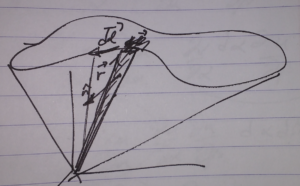[Click here for a PDF of this post with nicer formatting]
One of the results of this problem is required for a later one on magnetic moments that I’d like to do.
Question: Vector Area. ([1] pr. 1.61)
The integral
\begin{equation}\label{eqn:vectorAreaGriffiths:20}
\Ba = \int_S d\Ba,
\end{equation}
is sometimes called the vector area of the surface \( S \).
(a)
Find the vector area of a hemispherical bowl of radius \( R \).
(b)
Show that \( \Ba = 0 \) for any closed surface.
(c)
Show that \( \Ba \) is the same for all surfaces sharing the same boundary.
(d)
Show that
\begin{equation}\label{eqn:vectorAreaGriffiths:40}
\Ba = \inv{2} \oint \Br \cross d\Bl,
\end{equation}
where the integral is around the boundary line.
(e)
Show that
\begin{equation}\label{eqn:vectorAreaGriffiths:60}
\oint \lr{ \Bc \cdot \Br } d\Bl = \Ba \cross \Bc.
\end{equation}
Answer
(a)
\begin{equation}\label{eqn:vectorAreaGriffiths:80}
\begin{aligned}
\Ba
&=
\int_{0}^{\pi/2} R^2 \sin\theta d\theta \int_0^{2\pi} d\phi
\lr{ \sin\theta \cos\phi, \sin\theta \sin\phi, \cos\theta } \\
&=
R^2 \int_{0}^{\pi/2} d\theta \int_0^{2\pi} d\phi
\lr{ \sin^2\theta \cos\phi, \sin^2\theta \sin\phi, \sin\theta\cos\theta } \\
&=
2 \pi R^2 \int_{0}^{\pi/2} d\theta \Be_3
\sin\theta\cos\theta \\
&=
\pi R^2
\Be_3
\int_{0}^{\pi/2} d\theta
\sin(2 \theta) \\
&=
\pi R^2
\Be_3
\evalrange{\lr{\frac{-\cos(2 \theta)}{2}}}{0}{\pi/2} \\
&=
\pi R^2
\Be_3
\lr{ 1 – (-1) }/2 \\
&=
\pi R^2
\Be_3.
\end{aligned}
\end{equation}
(b)
As hinted in the original problem description, this follows from
\begin{equation}\label{eqn:vectorAreaGriffiths:100}
\int dV \spacegrad T = \oint T d\Ba,
\end{equation}
simply by setting \( T = 1 \).
(c)
Suppose that two surfaces sharing a boundary are parameterized by vectors \( \Bx(u, v), \Bx(a,b) \) respectively. The area integral with the first parameterization is
\begin{equation}\label{eqn:vectorAreaGriffiths:120}
\begin{aligned}
\Ba
&= \int \PD{u}{\Bx} \cross \PD{v}{\Bx} du dv \\
&= \epsilon_{ijk} \Be_i \int \PD{u}{x_j} \PD{v}{x_k} du dv \\
&=
\epsilon_{ijk} \Be_i \int
\lr{
\PD{a}{x_j}
\PD{u}{a}
+
\PD{b}{x_j}
\PD{u}{b}
}
\lr{
\PD{a}{x_k}
\PD{v}{a}
+
\PD{b}{x_k}
\PD{v}{b}
}
du dv \\
&=
\epsilon_{ijk} \Be_i \int
du dv
\lr{
\PD{a}{x_j}
\PD{u}{a}
\PD{a}{x_k}
\PD{v}{a}
+
\PD{b}{x_j}
\PD{u}{b}
\PD{b}{x_k}
\PD{v}{b}
+
\PD{b}{x_j}
\PD{u}{b}
\PD{a}{x_k}
\PD{v}{a}
+
\PD{a}{x_j}
\PD{u}{a}
\PD{b}{x_k}
\PD{v}{b}
} \\
&=
\epsilon_{ijk} \Be_i \int
du dv
\lr{
\PD{a}{x_j}
\PD{a}{x_k}
\PD{u}{a}
\PD{v}{a}
+
\PD{b}{x_j}
\PD{b}{x_k}
\PD{u}{b}
\PD{v}{b}
}
+
\epsilon_{ijk} \Be_i \int
du dv
\lr{
\PD{b}{x_j}
\PD{a}{x_k}
\PD{u}{b}
\PD{v}{a}
–
\PD{a}{x_k}
\PD{b}{x_j}
\PD{u}{a}
\PD{v}{b}
}.
\end{aligned}
\end{equation}
In the last step a \( j,k \) index swap was performed for the last term of the second integral. The first integral is zero, since the integrand is symmetric in \( j,k \). This leaves
\begin{equation}\label{eqn:vectorAreaGriffiths:140}
\begin{aligned}
\Ba
&=
\epsilon_{ijk} \Be_i \int
du dv
\lr{
\PD{b}{x_j}
\PD{a}{x_k}
\PD{u}{b}
\PD{v}{a}
–
\PD{a}{x_k}
\PD{b}{x_j}
\PD{u}{a}
\PD{v}{b}
} \\
&=
\epsilon_{ijk} \Be_i \int
\PD{b}{x_j}
\PD{a}{x_k}
\lr{
\PD{u}{b}
\PD{v}{a}
–
\PD{u}{a}
\PD{v}{b}
}
du dv \\
&=
\epsilon_{ijk} \Be_i \int
\PD{b}{x_j}
\PD{a}{x_k}
\frac{\partial(b,a)}{\partial(u,v)} du dv \\
&=
-\int
\PD{b}{\Bx} \cross \PD{a}{\Bx} da db \\
&=
\int
\PD{a}{\Bx} \cross \PD{b}{\Bx} da db.
\end{aligned}
\end{equation}
However, this is the area integral with the second parameterization, proving that the area-integral for any given boundary is independant of the surface.
(d)
Having proven that the area-integral for a given boundary is independent of the surface that it is evaluated on, the result follows by illustration as hinted in the full problem description. Draw a “cone”, tracing a vector \( \Bx’ \) from the origin to the position line element, and divide that cone up into infinitesimal slices as sketched in fig. 1.
The area of each of these triangular slices is
\begin{equation}\label{eqn:vectorAreaGriffiths:160}
\inv{2} \Bx’ \cross d\Bl’.
\end{equation}
Summing those triangles proves the result.
(e)
As hinted in the problem, this follows from
\begin{equation}\label{eqn:vectorAreaGriffiths:180}
\int \spacegrad T \cross d\Ba = -\oint T d\Bl.
\end{equation}
Set \( T = \Bc \cdot \Br \), for which
\begin{equation}\label{eqn:vectorAreaGriffiths:240}
\begin{aligned}
\spacegrad T
&= \Be_k \partial_k c_m x_m \\
&= \Be_k c_m \delta_{km} \\
&= \Be_k c_k \\
&= \Bc,
\end{aligned}
\end{equation}
so
\begin{equation}\label{eqn:vectorAreaGriffiths:200}
\begin{aligned}
(\spacegrad T) \cross d\Ba
&=
\int \Bc \cross d\Ba \\
&=
\Bc \cross \int d\Ba \\
&=
\Bc \cross \Ba.
\end{aligned}
\end{equation}
so
\begin{equation}\label{eqn:vectorAreaGriffiths:220}
\Bc \cross \Ba = -\oint (\Bc \cdot \Br) d\Bl,
\end{equation}
or
\begin{equation}\label{eqn:vectorAreaGriffiths:260}
\oint (\Bc \cdot \Br) d\Bl
=
\Ba \cross \Bc.
\end{equation}
References
[1] David Jeffrey Griffiths and Reed College. Introduction to electrodynamics. Prentice hall Upper Saddle River, NJ, 3rd edition, 1999.
